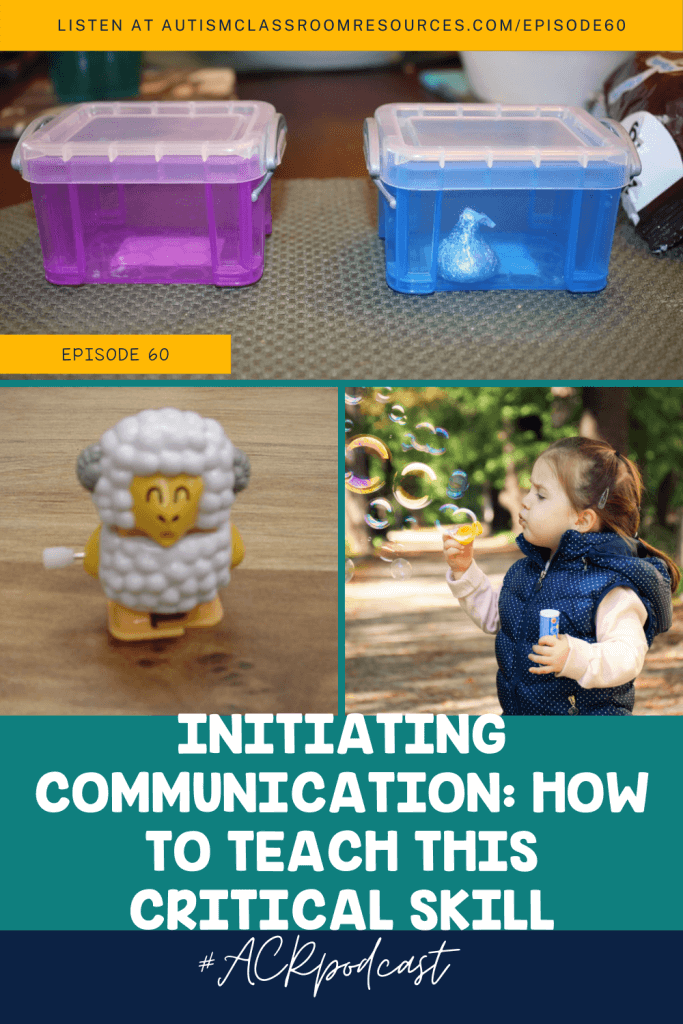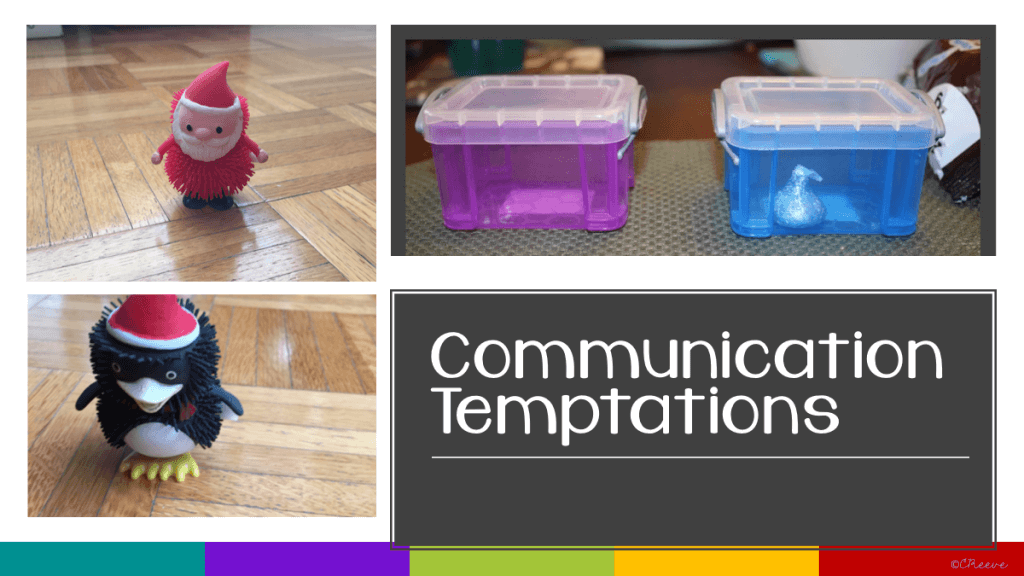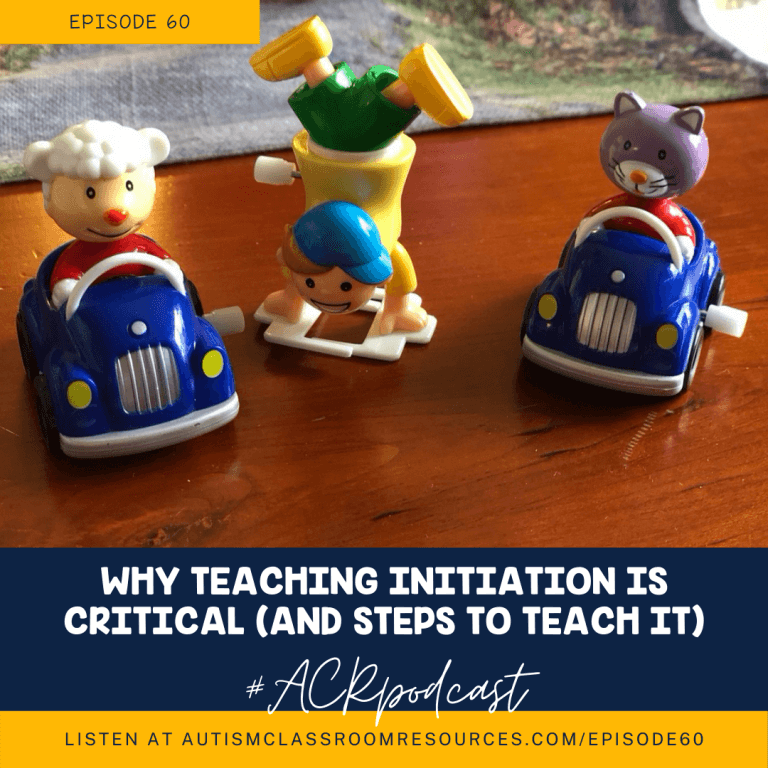In last week’s episode I touched on why initiating communication is so important for students with autism and other disabilities. I consider it one of the most complex but important parts of teaching communication. Students with autism, in particular, often have difficulty initiating any action. There are a wide variety of reasons about this related to how information is processed and their perception of social interactions. Those reasons are really too intricate to cover in a podcast. And they aren’t as important to education as the process of teaching initiating communication.
Why is Initiating Communication Important?
Communication initiation takes a variety of communicative functions. It includes initiating requests, initiating protests, asking for assistance, and initiating conversation. Initiating communication is a lifelong skill that is critical to independent functioning.
What if I have the flu and don’t have the skill to initiate communication to ask someone to take me a doctor? If I can’t drive myself, I’m going to have a problem.
Imagine someone else manages my money and I need money for groceries. I’ve had adults who have empty shelves and refrigerators in this situation. Their family thought they would tell them they needed money. The adult knew she needed money, but assumed others knew and didn’t initiate the request.
And of course it comes down to even more basic issues. How do I know a student needs help with an assignment if she doesn’t tell me? What if a student is in pain but doesn’t let us know? Imagine a student who had ants in his shoes after recess and didn’t tell anyone he was being bitten. No one knew until he got home and Mom took his shoes off. His teachers had no idea because he didn’t show signs, but he also didn’t initiate that something hurt.
How to Teach Initiating Communication
So in today’s episode I’m going to share steps for creating opportunities and teaching initiation communication to your students. This strategy goes by many names. While there may be some differences in the application of it for different fields, the essential elements are basically the same.
You will see it described as communication temptations, situational sabotage, natural environment teaching (NET), incidental teaching, Pivotal Response Training (PRT) and probably others I can’t think of at the moment. However, the focus of them all is the same: to create an opportunity that motivates the learner to initiate communication to get something
1. Choose the Language Skill
Do you want the student to request something he or she needs? Comment on something (e.g., I see a dog before you turn the page of the book)? Initiate a greeting? The situation you set up will depend on what the skill is you want to address.
Typically I start with requesting something highly desired. If your student isn’t asking for the things he really wants, it’s unlikely he is going to be initiating commenting or conversation. And choosing the highest motivating activity is going to be key to get the initiating going.
Keep in mind that this is where we start. We can modify over time to move from initiating requests for highly desired items to initiating conversation and initiating other functions. But requesting is where we start because it’s highly motivating and reinforcing.
Do you want to get one word for a request or would you settle for a gesture? For some students, handing you the bubbles to open would be sufficient to indicate they are trying to communicate. For others you might want them to say, “I want a turn with the bubbles” or “I want more bubbles please.”
Determine what type of communication you are going for (making sure you have the needed supports like picture cards or switches programmed) and then encourage that. A good rule of thumb is to start with where the student is NOW. If he or she is nonverbal, start with a gesture, a speech generating device, or a picture. But if a student is verbal but not initiating (a common combination with ASD), you might start with visual cues and one word.
Knowing what form you will accept ahead of time is important for a couple of reasons. First, it allows you to know what you are going to reinforce when the student initiates in that way. Second, it makes sure you can communicate that information to all of the staff so everyone reinforces it.
3. Create a Motivating Opportunity
Find something that captivates the individual’s interest or something that he or she needs at that moment. You might do a reinforcer assessment to figure out what is motivating. And remember, as I talk about in episode 25, you have to sell it. You have to heighten your affect to make it interesting. The expectant waiting is important as well as I talk about in Episode 54. It’s about walking the balance between tempting and frustrating. It’s a fine line but we have to work at finding it. Remember, if I give the student everything, he has not need to initiate.
Praactical AAC gives an excellent example of turning the heat on in a car in Florida to motivate the communicator to ask the driver to cool it down. Another one is to give small portions of something desired or needed. For instance, give a really salty snack and then either hold back on a drink or only give a very small portion of a drink so the learner has to ask for more.
Wind up toys are great for communication temptations for young students (and sometimes for me) if they can’t wind up the toy or spin the top themselves. This creates a natural opportunity to communicate in some way to get more or assistance to make it go again. Bubbles are great for teaching “open,’ ‘help” or “more” in order to get them open.
4. Wait Expectantly
This is the hardest part. I think waiting is the hardest part of any teaching, but it is what creates the opportunity for learning. And in initiating communication, it’s critical. If we talk first, we ruin the opportunity. Waiting doesn’t mean just sitting there though.
If the student isn’t responding, try shrugging your shoulders in a “I don’t know” to indicate you are waiting. Eat or play with the item in question (“Ummm, popcorn is so salty!”). Or talk to another student about how cool it will be to blow bubbles or something similar.
The expectant waiting is critically important as I talk about in Episode 54. It’s about walking the balance between tempting and frustrating. It’s a fine line but we have to work at finding it. Remember, if I give the student everything, he has not need to initiate.
Avoid asking, “What do you want?” or “Do you want more?” or “What do you see?” Then the student will be answering a question instead of initiating.
If you want a reminder to post in your classroom to help everyone remember to wait for communication, you can download this picture (without my website name on the bottom) for free HERE.
5. Give a Prompt if Needed
If the student doesn’t initiate at the level you want, model what you want him or her to say or physically prompt them to give you the picture or the item to open, wind etc. Again, try to avoid asking, “what do you want” so that when you reinforce with the item, you are reinforcing at least prompted initiation rather than just responding. The key is to balance the student’s discomfort or frustration with the learning.
Jump in BEFORE the student gets too upset and prompt if needed. It’s a tightrope of trying to push them out of their comfort zone of others anticipating their needs but not so far out that they become frustrated or disinterested.
6. Reinforce
When the individual communicates in some fashion that is acceptable to your goal, you reinforce by giving them what they are working with or wanting. So if they ask for open with the bubbles, you blow bubbles. If they ask for a snack, they get a snack. Do they comment on something? Respond by giving them the item if it is something they like.
If you prompt the student, give him or her the item they asked for or the response they are looking for, but give them just a small bit. But, if the student initiates independently, give them lots of the desired item or response. Remember it’s not all or none. You can differentiate your reinforcement according to the response.
Initiating Communication Instruction Tips
The beauty of this system is that you are capitalizing on the individual’s own motivation and they get reinforced by something they have demonstrated they are motivated by. Plus, the reinforcement is likely to generalize and maintain because it’s happening in the same way it would in the natural environment.
The key to independence is to make sure there is a good, noticeable difference in reinforcement quality and / or quantity when the student is independent versus just a little bit to acknowledge the response when they need assistance. This makes it more likely that the independent responses will increase and prompted ones will decrease.








